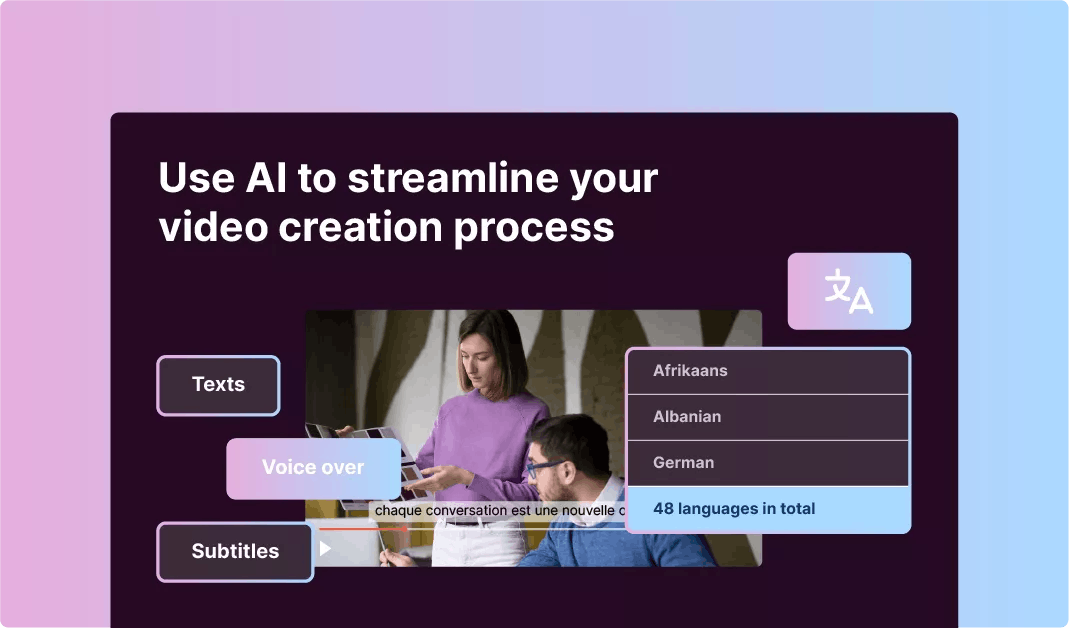What are the prerequisites for managing a project?

Digital transformation projects involve various changes for employees and executives, from new tools to new management and new partners.
To implement these changes, work needs to be done in several areas:
- engaging, informing and training employees;
- adapting the IT Department to the new digital solutions;
- driving leadership and senior management to support the project;
- giving managers the necessary tools to drive and steer change;
- improving employee efficiency;
- maintaining these new practices in the long term;
- promoting innovation as a fundamental value of corporate culture.
And now, change means creating valuable content, on a regular basis. Most companies are now encouraging their teams to use an online video editor, a video maker allowing them to create videos for their different departments (communication, HR, marketing…).
Implementing new communication processes and tools
Knowledge and digital culture are often shared among employees by the implementation of new communication tools or media. It’s increasingly common for innovation departments to request that a corporate social network or web TV channel be created to talk about an innovative topic. New media like video and corporate social media are essential to a successful digital transformation. It seems contradictory not to use innovative and digital media to talk about new digital solutions.
Communication on the implementation of digital projects is key, because it’s the only way to ensure that all of those involved are on board with the project. It’s important to remember that the main factor leading to the failure of digital projects is the human factor and, more specifically, resistance to change. So effective and enhanced digital communication is a prerequisite for success.
To choose the right tool, it’s also important to identify the goals of the communication. Will these communication tools be used to manage projects, for informal exchanges or as a way to train employees by capitalising on internal resources?
Once these tools are in place, it will also be necessary to communicate on the right topics. User feedback is very useful for achieving this goal. They illustrate the reasons for using the new digital solution, as well as how it’s used and the result of its use. Other content produced by major project sponsors (supervisors and senior management, among others) can also include information about good practices as promotional content.
One of these tools can be an online video editing software.
How digital culture accelerates the adoption of a new solution
Corporate culture can be defined as the knowledge and values that help a business run smoothly when it’s shared by most of its members. For some businesses, this culture reinforces teamwork and makes it easier for employees to participate in new projects.
In other words, a company that makes innovation a pillar of its corporate culture will be more inclined to adopt new solutions. This may seem obvious for digital companies and tech start-ups, but we should also be aware that this isn’t always the case. Some businesses, particularly some large industrial groups, require greater support in change management and the adoption of a new culture that promotes innovation.
The IT department and general management: two key sponsors
The recent GDPR has put the IT Department in the spotlight by highlighting its strategic role and position as business partner within organisations. The IT Department can’t be bypassed in 2019 when putting in place a new digital solution. Only this department can support the uses of the solution, according to its corporate vision and inherent constraints. The IT Department clearly plays a supporting role first and then, ideally, acts as a driving force in the process of adopting a new digital tool.
The role of the general management is complementary to that of the IT Department. Its first role is to communicate about a corporate culture that’s open to change and transformation. Its support for new digital initiatives is essential. As a pillar of the organisation, general management acts as a spokesperson to explain the advantages of this new solution for employees in their jobs and for the company in facing its business challenges.
How to invest in training according to your level of digital maturity
Last but not least, training also plays a major role in digital transformation projects.
Digital projects require training on a rather large scale. In this regard, video can be considered either as a training tool in itself, for tutorials or MOOCs, or as a supplementary educational tool for training strategies that combine in-person and digital elements. It’s important to note that video is a suitable and effective format for explaining a topic, breaking down a concept and simplifying complex mechanisms.
If a business hasn’t made innovation the driving force of its corporate culture, general management needs to train managers in the new digital culture. This is the first key component of training. Especially considering that our senior managers are now working alongside Generation Y-ers and millennials. While older generations need to catch up, the new generations are taking on their roles on the basis of a solid digital culture (collaboration in open innovation, participation in large group/start-up relationships, agile work, etc.). This work aimed at developing skills and promoting the corporate culture needs to be undertaken by the company. It needs to provide employees with training systems for the adoption of new digital solutions, either on its own, with a service provider or with a partner.
Then it needs to organise the way in which employees develop their skills or communicate information related to the new technology being implemented. This is the second stage of training required for this kind of project to ensure the full adoption of the tool.
So the success of a digital transformation project depends, on the one hand, on your ability to include all your employees in the process (information and training) and, on the other, on your determination to establish a true digital culture if it’s not already in place. The technical support provided by the IT Department and the strategic support of general management are also key to long-term adoption.
Resources













